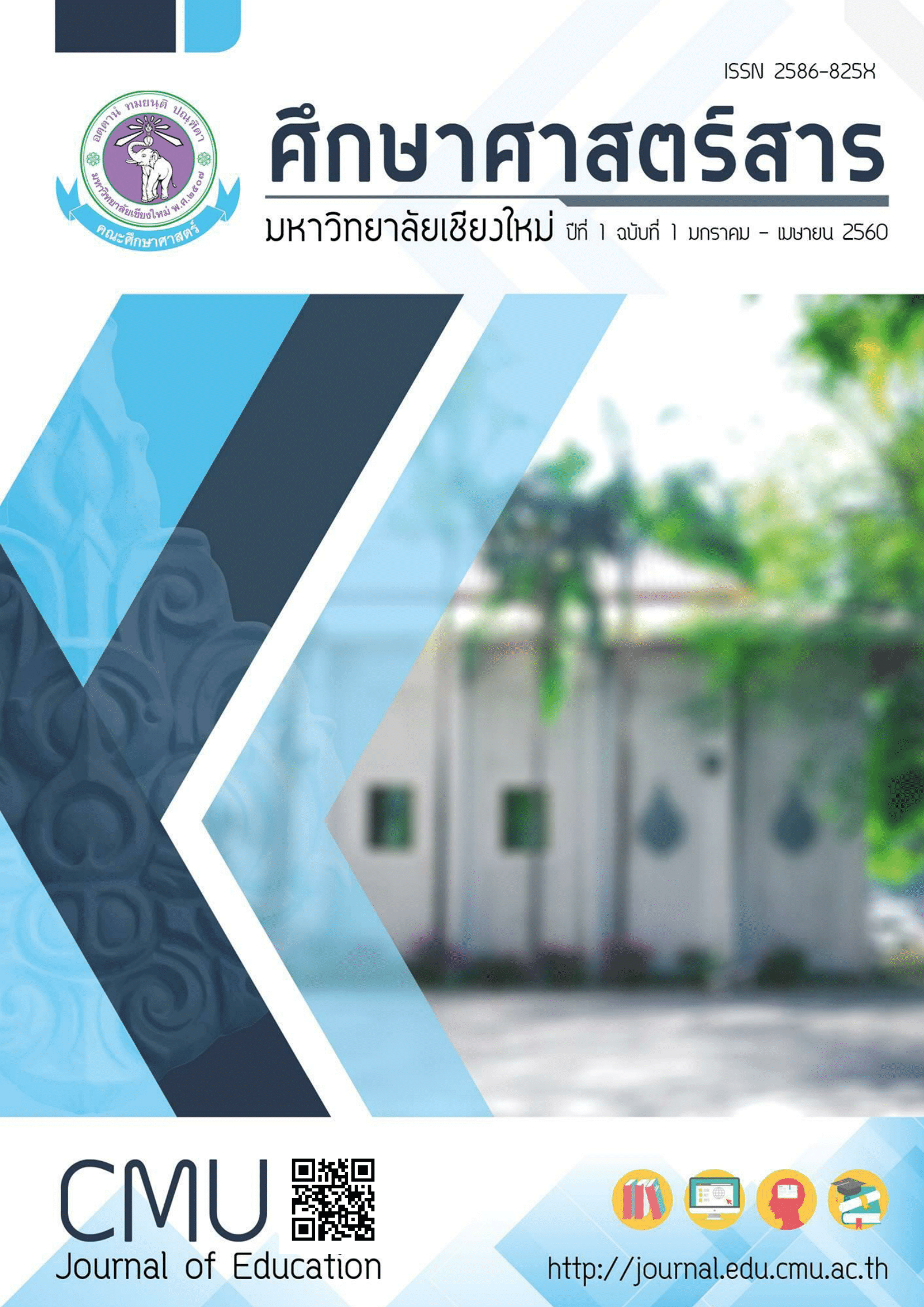จากโลกกายภาพสู่โลกสัญลักษณ์ : กระบวนการเรียนรู้เรื่องการบวกของนักเรียน ชั้นประถมศึกษาปีที่ 1 ในชั้นเรียนที่สอนด้วยวิธีการแบบเปิด
Main Article Content
บทคัดย่อ
การวิจัยครั้งนี้มีวัตถุประสงค์เพื่อวิเคราะห์กระบวนการเรียนรู้เรื่องการบวกผ่านกระบวนการความเป็นนามธรรมจากโลกกายภาพสู่โลกสัญลักษณ์ที่เกิดขึ้นในชั้นเรียนคณิตศาสตร์ ชั้นประถมศึกษาปีที่ 1ที่ใช้นวัตกรรมการศึกษาชั้นเรียนและวิธีการแบบเปิด งานวิจัยนี้อาศัยแนวคิดเกี่ยวกับทฤษฎีสามโลกทางคณิตศาสตร์ของ David Tall เป็นหลักในการวิเคราะห์ข้อมูลผ่านชิ้นงานนักเรียน และฉากชั้นเรียนด้วยการวิเคราะห์โพรโทคอล ผลการวิจัยพบว่านักเรียนแสดงแนวคิดเกี่ยวกับการบวกจากการบีบอัดที่เพิ่มขึ้นของสัญลักษณ์บนช่วงห่างของโลกกายภาพสู่โลกสัญลักษณ์ โดยนักเรียนแก้ปัญหาด้วยแนวคิดของการรวมและเพิ่มขึ้น ด้วยการนับบล็อคหนึ่งหน่วยและแท่งสิบที่แสดงถึงการแยกจำนวนเพื่อทำให้เป็นสิบด้วยความรู้ที่นักเรียนเคยเรียนรู้มาแล้ว จากนั้นนักเรียนใช้ไดอะแกรมเป็นสัญญะเชิงภาพที่พัฒนาขึ้นเป็นเครื่องมือเชิงสัญลักษณ์ในฐานะที่เป็นความคิดรวบยอดเชิงกระบวนการเพื่อแก้ปัญหาอื่นที่ซับซ้อน
Article Details
หากผู้เสนอบทความมีความจำเป็นเร่งด่วนในการตีพิมพ์โปรดส่งลงตีพิมพ์ในวารสารฉบับอื่นแทน โดยกองบรรณาธิการจะไม่รับบทความหากผู้เสนอบทความไม่ปฏิบัติตามเงื่อนไขและขั้นตอนที่กำหนดอย่างเคร่งครัด ข้อมูลของเนื้อหาในบทความถือเป็นลิขสิทธิ์ของ Journal of Inclusive and Innovative Education คณะศึกษาศาสตร์ มหาวิทยาลัยเชียงใหม่
เอกสารอ้างอิง
ณิศรา สุทธิสังข์. (2556). หน้าที่ของกระบวนการนามธรรมเพื่อสร้างความคิดรวบยอดของนักเรียนผ่านกิจกรรมทางคณิตศาสตร์ในชั้นเรียนที่ใช้การศึกษาชั้นเรียนและวิธีการแบบเปิด (วิทยานิพนธ์ปริญญาปรัชญาดุษฎีบัณฑิต). สาขาวิชาคณิตศาสตรศึกษา บัณฑิตวิทยาลัย มหาวิทยาลัยขอนแก่น.
Cobb, P., Wood, T. and Yackel, E. (1991). A constructivist approach to second grade mathematics. In
E. Von Glasersfeld (Ed.). Radical constructivism in mathematics education. (pp. 157-176).
Dordrecht, Netherlands: Kluwer.
Cobb,P., Confrey, J. and Schauble, L. (2003). Design experiments in educational research.
Educational Researcher, 32, 1, 9 – 13.
Inprasitha, M. (2010). One feature of adaptive lesson study in Thailand –Designing learning unit.
Proceedings of the 45th Korean National Meeting of Mathematics Education,
Dongkook University, Gyeongju. (pp.193-206). South Korea: Dongkook University.
Isoda, M. (2010). Japanese theories for lesson study in mathematics education: A case of problem
solving approach. In Y. Shimizu, Y. Sekiguchi, & K. Hatano (Eds.), Proceedings of the
th East Asia Regional Conference on Mathematics Education (EARCOME5) (pp.176-181).
Tokyo: National Olympics Memorial Youth Center.
National Council of Teachers of Mathematics. (2000). Principles and standards for school
Mathematics. Reston: The National Council of Teachers of Mathematics.
Tall, D. (2004). Introducing Three Worlds of Mathematics. For the Learning of Mathematics, 23 (3),
–33.
Tall, D. (2006). A Theory of Mathematical Growth through Embodiment, Symbolism and Proof. Annales de Didactique et de Sciences Cognitives, 11, 195–215.
Tall, D., & Isoda, M. (2007). Long-term development of mathematical thinking and lesson study. Singapore: World Scientific Publishing Co.


